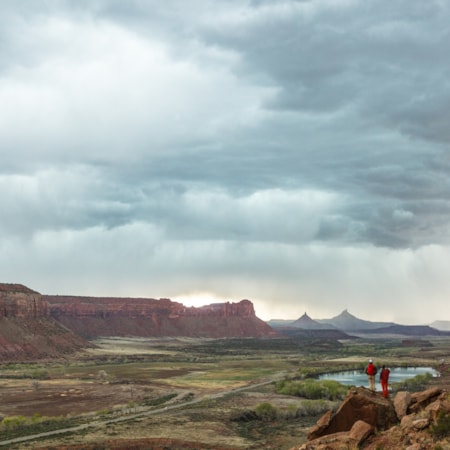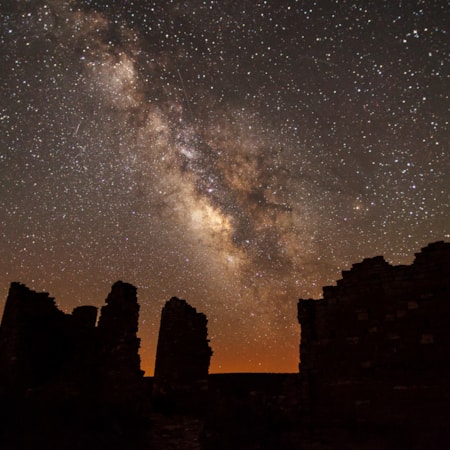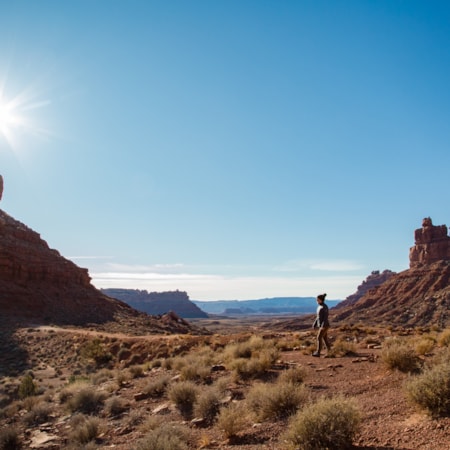Bears Ears Area Starter Kit
With the help of local expertise, respectfully explore ancestral cliff dwellings and massive natural bridges in a fascinating desert ecosystem.
A pair of towering, distant buttes stand against beautiful scenery. The twin buttes are so distinctive that in each of the native languages of the region their name is the same: Hoon'Naqvut, Shash Jáa, Kwiyagatu Nukavachi, Ansh An Lashokdiwe, or in English: Bears Ears. (Your best view of the Bears Ears occurs on the third day of this itinerary, but they are not a primary destination.)
Bears Ears National Monument covers a broad expanse of red rock, juniper forests, high plateau, cultural, historic and prehistoric legacy that includes an abundance of early human and Native American historical artifacts left behind by early Clovis people, then later Ancestral Puebloans, Fremont culture and others. The Navajo Nation, Ute Mountain Ute Tribe, Hopi Nation and other tribes have close, contemporary connections to the land.
Perhaps many road trips have covered the distance between Moab and Monument Valley without realizing what’s out there. The national monument provides a glimpse into the diverse lands that stretch across the southeastern corner of Utah, in the famed Four Corners region of the United States. You'll visit ancestral cliff dwellings, examine the desert ecosystem and stand beneath gargantuan natural bridges and interact with the communities of locals and Native cultures that call it all home.
Much of Bears Ears National Monument is remote and requires a combination of wayfinding skills and a high-clearance vehicle to access — or the savvy of a well-prepared backpacker. Much of Bears Ears is fragile, too. Travelers to any of the thousands of ancestral sites, including cliff dwellings and kivas, testaments to astonishing architectural prowess and strong prehistoric communities, should visit with extreme care (Read: How to Visit Rock Imagery Sites Like an Archaeologist). Appreciate from afar. Examine potsherds, arrowheads and other fragments of past cultures with awe, but leave in the places where you find them. Note the imprint of some ancient thumb in the adobe mortar, but leave no trace of your own.
You could lose yourself for days out here, but your Bears Ears Area Starter Kit introduces you to the experiences, places, history and people that give definition to these fascinating lands.

Introduction to Bears Ears
160 Miles
- Indian Creek Corridor Scenic Byway
- Mule Canyon's House on Fire and Cave Tower
- Edge of the Cedars State Park Museum
If traveling south from the Moab area, start with an exploratory drive through the northern area of Bears Ears, on the Indian Creek Corridor Scenic Byway, including a stop at Newspaper Rock State Historic Site. Though not the focus of this itinerary, if your schedule permits, add a day (or much more!) for a visit to the Needles District of Canyonlands National Park, at the end of the byway. Your best introduction to Bears Ears might just be a stop at Edge of the Cedars State Park Museum in Blanding, whose collection highlights artifacts and lifestyle of Ancestral Puebloan culture. South of Blanding, introductory hikes to the cliff dwellings of Bears Ears include House on Fire and Cave Towers, but an even more accessible and well-interpreted trail is the Butler Wash Ruins Overlook.
Overnight in Monticello, Blanding or Bluff for lodging, or the IDA-certified International Dark Sky Park Hovenweep National Monument for camping, stargazing and early start to tomorrow’s adventure. (More information on day two.)

Ancestral Lives and Contemporary Art
70 Miles
If you camped overnight in Hovenweep National Monument and the skies were clear, you’ll proceed starstruck to the well-interpreted trails of the monument to peer into the lives of an ancient culture who built astonishing multistoried towers on the edge of a canyon more than 700 years ago. Meanwhile, Bluff, Utah, is a small town with a big personality and serves great local food and coffee while the nearby Twin Rocks Trading Post honors local Navajo artists with fairly priced, museum-caliber baskets and art. The tour continues near the southern end of Bears Ears, with an easy stop at Sand Island petroglyphs and a more challenging visit to the River House site, which showcases a confluence of ancient culture with Mormon pioneer culture. Visit the Bears Ears Education Center or the Bluff Fort Historic Site to fill in the details of the area's past.
Lodgers can reserve overnight accommodations in Bluff or you could consider adding a day to this itinerary with an overnight and tour of Monument Valley Navajo Tribal Park.

Goosenecks, Gods and Bridges
90 Miles
As scenic as the trip has been so far, on day three the skies get bigger and the vistas broader as you ascend in elevation to peer down at the meandering San Juan River at Goosenecks State Park and explore the Valley of the Gods Scenic Backway on an unpaved road through landscapes sometimes described as a miniature Monument Valley — think red rock monoliths below rolling clouds. The drive continues up the unpaved and narrow switchbacks of the Moki Dugway of S.R. 261 — excluding of large RVs and trailers — to crest the vast and lush Cedar Mesa. Here, the eponymous Bears Ears formation come fully into view, two distinctive buttes rising from the mesa, which will stay in your windshield as you traverse Cedar Mesa en route to Natural Bridges National Monument. Natural Bridges can be enjoyed with an auto tour, stopping at overlooks, but adventurous hikers will want to descend into the canyon at least once to stand beneath some of the world’s largest natural bridges.
Explore More
-
Bluff Fort Historic Site
When you visit this area, you’ll really get a feeling for what life was like as a pioneer. You can walk around the original Bluff Fort, that has been rebuilt and restored through the efforts of the local organization, the Hole in the Rock Foundation.
-
Greater Cedar Mesa
The Cedar Mesa area encompasses up to 1.9 million acres and is home to more than 100,000 archaeological sites. For adventurers with a love of solitude, archaeology and geographic beauty, this area has it all.
-
Horseshoe Canyon
Canyonlands National Park
Horseshoe Canyon is a remote section of Canyonlands National Park that was added in 1972. Formerly known as Barrier Canyon, this area is home to some of the most impressive rock art created by the ancient Barrier Culture.
-
Monument Valley Guided Jeep Tours
Monument Valley
Butte after butte and mesas upon mesas are calling your name. The Valley Drive in the Monument Valley Navajo Tribal Park is just the road for you to heed their calls.
-
Muley Point Overlook
One of San Juan County’s hidden gems, the Muley Point Overlook has sweeping vistas to the south and includes clear views of the canyons below at sunrise and sunset.
